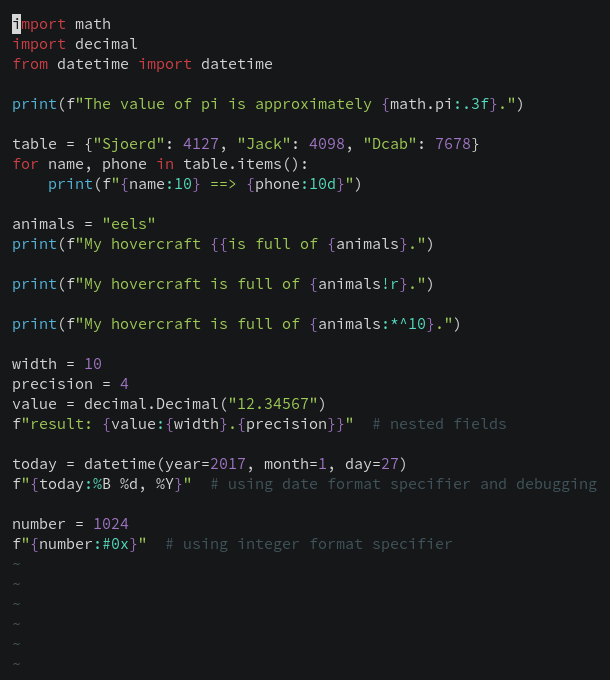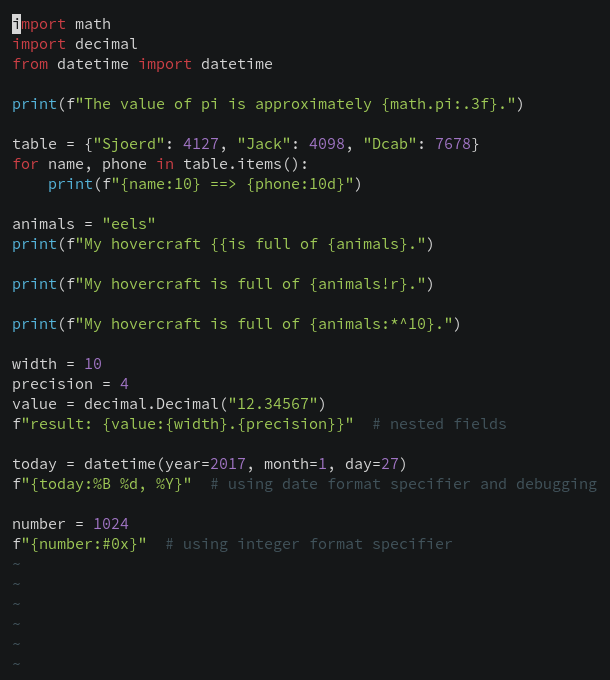Python f-strings syntax highlighting in Vim
Getting Python syntax highlighting to work in Vim requires very little code, to my surprise.
Here is everything that you need and an explanation below.
" in ~/.config/nvim/after/syntax or ~/.vim/after/syntax
syn match pythonEscape +{{+ contained containedin=pythonfString,pythonfDocstring
syn match pythonEscape +}}+ contained containedin=pythonfString,pythonfDocstring
syn region pythonfString matchgroup=pythonQuotes
\ start=+[fF]\@1<=\z(['"]\)+ end="\z1"
\ contains=@Spell,pythonEscape,pythonInterpolation
syn region pythonfDocstring matchgroup=pythonQuotes
\ start=+[fF]\@1<=\z('''\|"""\)+ end="\z1" keepend
\ contains=@Spell,pythonEscape,pythonSpaceError,pythonInterpolation,pythonDoctest
syn region pythonInterpolation contained
\ matchgroup=SpecialChar
\ start=+{{\@!+ end=+}}\@!+ skip=+{{+ keepend
\ contains=ALLBUT,pythonDecoratorName,pythonDecorator,pythonFunction,pythonDoctestValue,pythonDoctest
syn match pythonStringModifier /:\(.[<^=>]\)\?[-+ ]\?#\?0\?[0-9]*[_,]\?\(\.[0-9]*\)\?[bcdeEfFgGnosxX%]\?/ contained containedin=pythonInterpolation
syn match pythonStringModifier /![sra]/ contained containedin=pythonInterpolation
hi link pythonfString String
hi link pythonfDocstring String
hi link pythonStringModifier PreProcDeclaring a syntax region for f-strings
The first two lines define a new syntax region (see :h syn-region) called
pythonfString.
We then declare how it starts with the regex [fF]\@1<=\z(['"]\), which is
equivalent to (?:<=[fF])(['"]) in Perl regular expressions (see :h \@<=).
The second line just handles the case of a docstring.
The string will end how it starts, so we can just reference the captured group
using \z1 (we need to prefix it with z because it is an external pattern,
see :h \z().
The matchgroup argument tells Vim which highlight group it should use to
highlight the start/end pattern. The group pythonQuotes come from the default
syntax file.
Handling expressions inside f-strings
We also need to declare what this region contains.
For this we declare another region called pythonInterpolation, which starts
with { (but not with {{, which will actually produce a literal {) and
closes with }. With that in mind, we use the regex {{\@! because we don’t
want a match if the preceding token is present (see :h \@!).
This region may contain only expressions, so stuff like a function declaration
does not make sense (notice there is a syntax for that, :helpgrep ALLBUT)
Handling string modifiers
f-strings supports
str.format syntax
for formatting, for example:
import math
print(f"The value of pi is approximately {math.pi:.3f}.")So I read the Python docs and wrote a regex based on it, but regexes are always easier to write than to read so I wouldn’t recommend you trying.
It’s also possible to convert a value as if wrapping them in functions such as
ascii(), repr(), str() with !a, !r, !s respectively, so we need to
handle this also.
For this, I declared a syntax group with :h syn-match and pass the regexes
that should be used.
It should only be highlighted inside a pythonInterpolation so we take
advantage of the containedin argument (see :h syn-containedin).
Highlighting declared groups
Finally, we link these new highlight groups with an appropriate/whichever you
like highlight group (see :h hi-link and :h group-name). I chose String
for f-strings and PreProc for modifiers. And it should work as expected.

